Benefits and Use Cases of QSFP-100G-ZR4-S White Paper
Available Languages
Bias-Free Language
The documentation set for this product strives to use bias-free language. For the purposes of this documentation set, bias-free is defined as language that does not imply discrimination based on age, disability, gender, racial identity, ethnic identity, sexual orientation, socioeconomic status, and intersectionality. Exceptions may be present in the documentation due to language that is hardcoded in the user interfaces of the product software, language used based on RFP documentation, or language that is used by a referenced third-party product. Learn more about how Cisco is using Inclusive Language.
Extend your 100G reach to 80 km
As the global digital transformation swings into high gear, service providers and network operators need to transform their offerings to keep pace. Businesses, consumers, and governments now expect high-speed connectivity everywhere, even in rural locations. And as data-intensive applications continue to grow, the multifold increases in bandwidth demand that it’s time to transform existing 10G extended-reach networks to 100G networks.
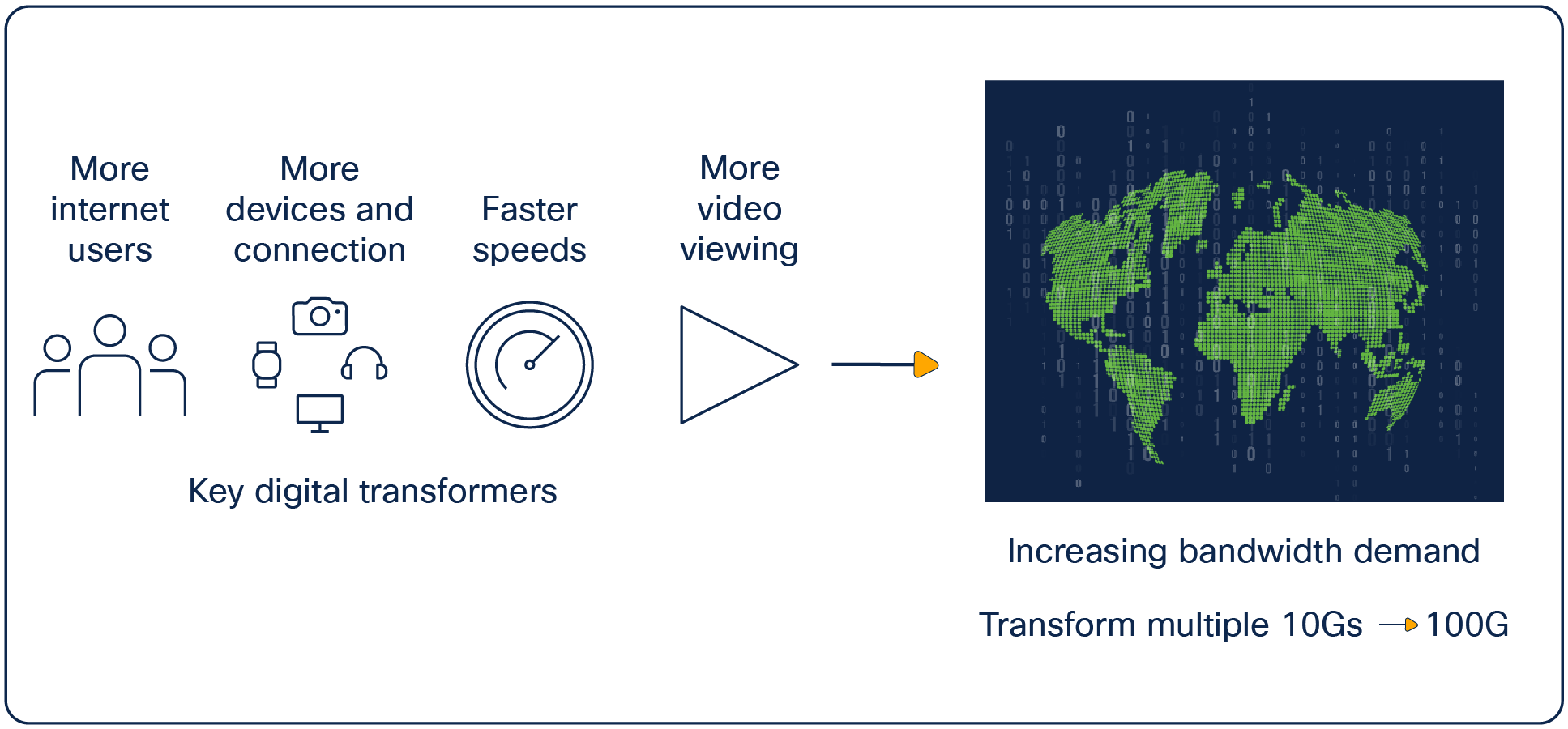
To respond, many operators are depending upon mature 100G technology, but optical signal impairments have previously limited the reach to a maximum of around 40 km. Now, the new QSFP-100G-ZR4-S can provide cost-effective 100G connectivity at reaches of up to 80 km* to service distant locations (see Figure 1).
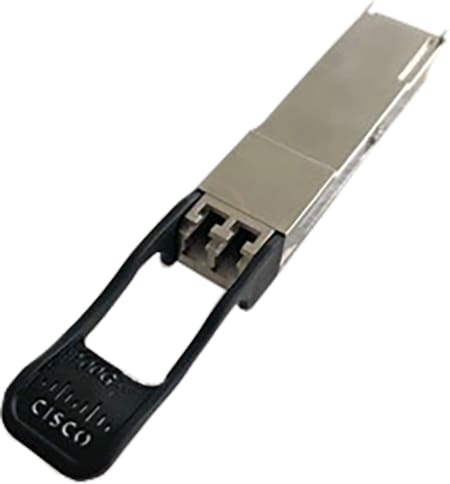
The Cisco QSFP-100G-ZR4-S pluggable module
There have been a variety of 100G QSFP28 modules that support distances ranging from 100 m to 40 km. At reaches beyond 40 km, chromatic dispersion and optical attenuation increase, reducing signal-to-noise ratio (SNR) and increasing bit-error rate. As a result, achieving 100G using QSFP28 at distances beyond 40 km has traditionally meant adding dispersion compensation/amplification boxes, using optical transport systems based on coherent optics, or deploying 40 km QSFP 100G modules at repeater locations with more 40 km QSFP 100G modules and equipment in between. All these approaches increase cost, complexity, and power consumption.
Other alternatives for customers seeking to upgrade their 80-km 10G links to 100G include repurposing 400G coherent technology using CFP2-DCO modules or QSFP-DD ZR modules. Both are designed for transport applications that support even longer reaches and deliver much higher speeds than needed for 80 km 100G applications, as well as drawing more power. They also require CFP2 or QSFP-DD ports, which may not be available on the existing equipment.
Given these issues, for many service providers and network operators with extended-reach applications enterprises connecting to regional data centers, service providers linking to out-of-region facilities, or telcos/MSOs bringing broadband to rural areas, for example the financials of traditional 100G beyond 40 km simply haven’t worked. Often, these companies continued to invest in 10G networks.
While 10G links don’t suffer the same limitations as 100G links, they also only provide a tenth of the capacity. Meanwhile, every year sees more internet users with more connected devices running more data-intensive applications. Adding extra 10G wavelengths or investing in additional fiber is expensive and doesn’t easily scale. These organizations need a practical 100G solution that will take them beyond 40 km. And now, with the release of the QSFP-100G-ZR4-S modules, they can achieve reaches of up to 80 km simply and cost-effectively.
QSFP-100G-ZR4-S optical modules deliver 100G connectivity up to 80 km without repeaters, courtesy of an integrated semiconductor optical amplifier (SOA). The technology enables operators and service providers to transform their networks (see Figure 2). They get up to a 10x bandwidth boost compared to existing single or multiple 10G links. Instead of running or leasing new fiber to meet demand, they can free up fiber for other applications or release it entirely. The upgrade lets them bring 100G capacity to their longer distance applications, while lowering the cost per bit.
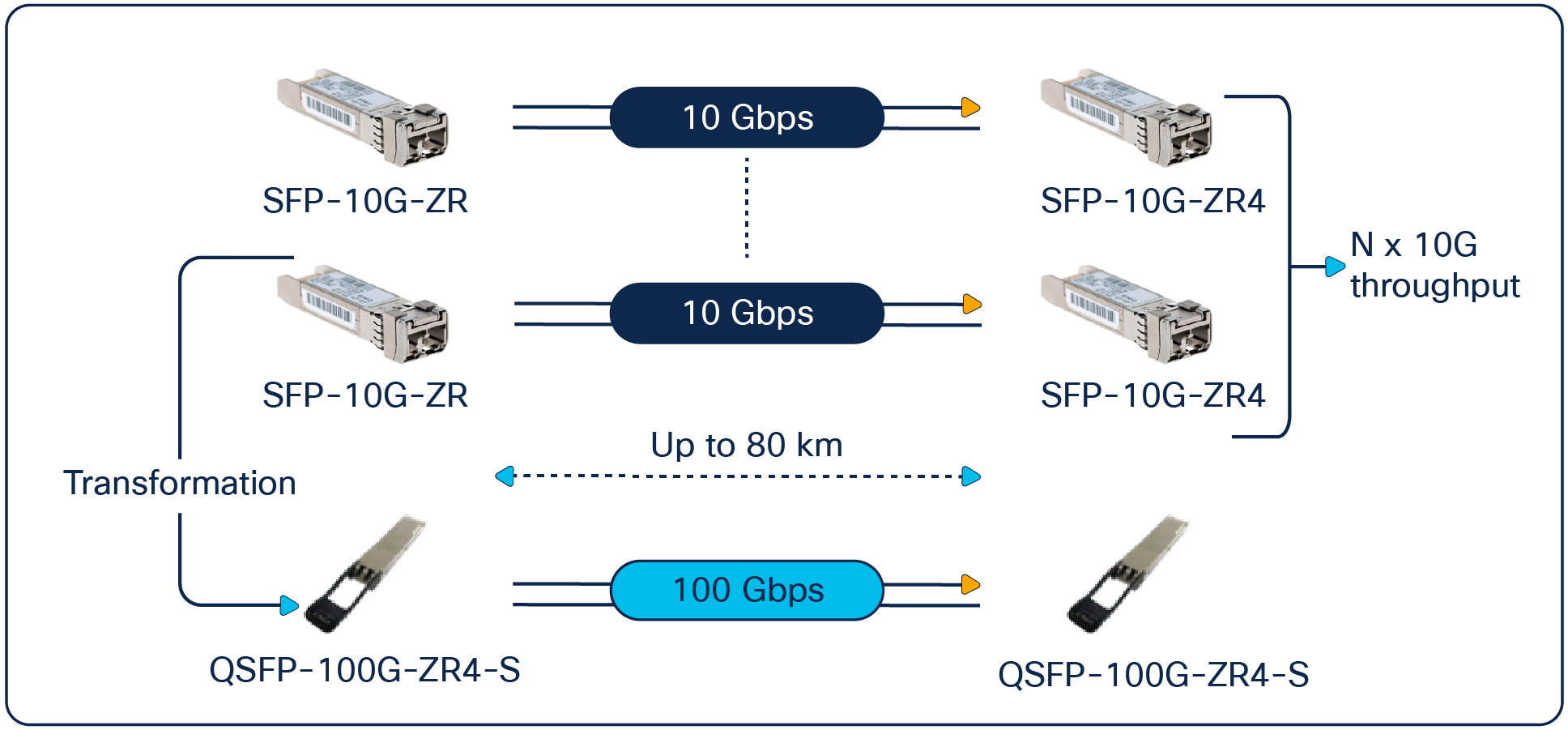
QSFP-100G-ZR4-S equips network operators to transform the services they offer to customers
Inside the QSFP-100G-ZR4-S Module
The QSFP-100G-ZR4-S was developed in response to customer demand for a practical 100G module with an 80-km reach. The individual technologies are all mature; the challenge was finding a way to combine them into a small device capable of operating within the QSFP28 power envelope. This was accomplished by incorporating several key technologies.
● Four 25G optical and electrical lanes (standard configuration for QSFP28, a mature technology deployed in millions of ports around the world)
● O-band operation (1295, 1300, 1304, and 1309 nm) to minimize chromatic dispersion
● An integrated SOA to compensate for attenuation (see Figure 3)
● High-power transmitter to maximize signal-to-noise ratio (SNR)
● Standard Non-Return-to-Zero (NRZ) modulation to simplify transmission and reception and ensure compatibility with existing infrastructure
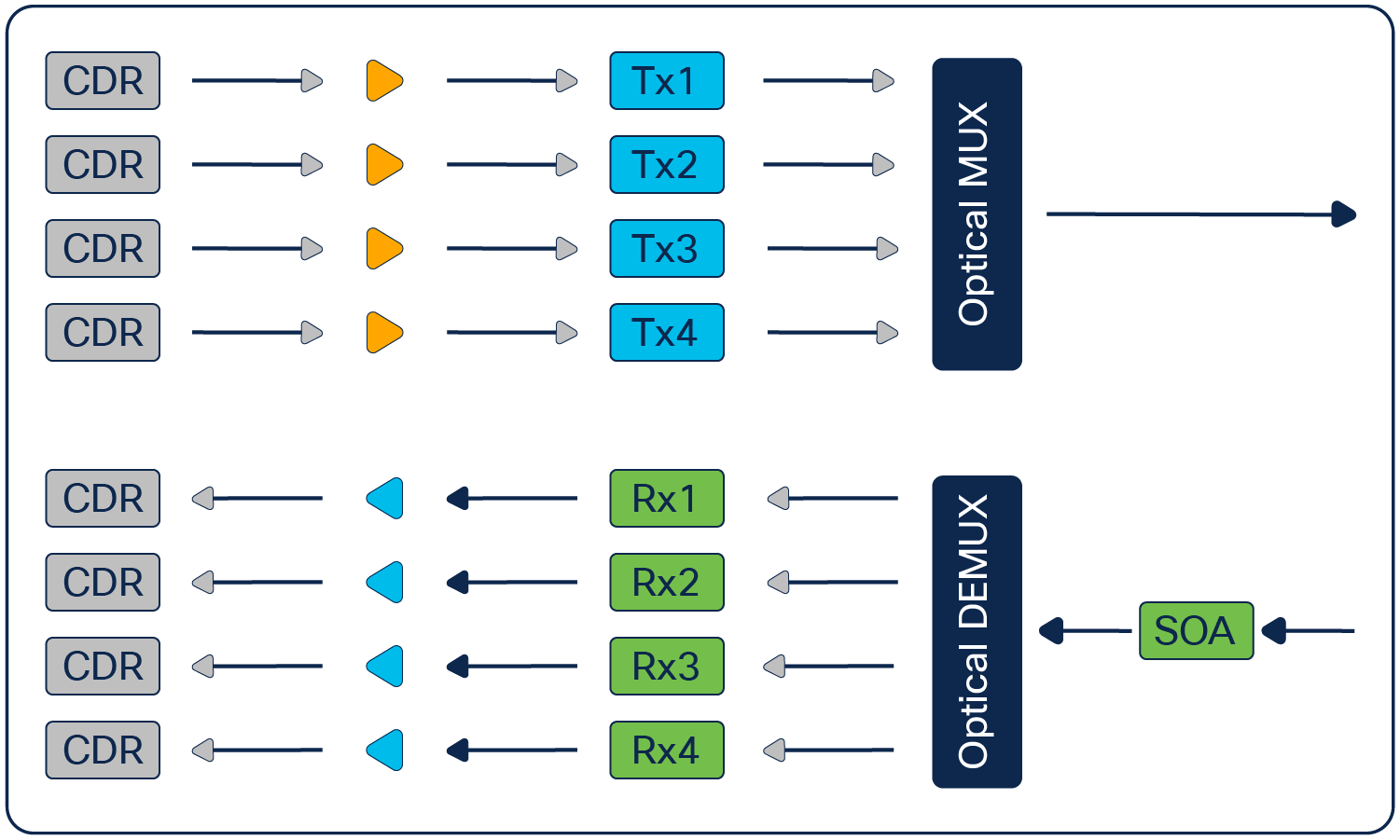
Inside the QSFP-100G-ZR4-S
Because the SOA is integrated in the module, the QSFP-100G-ZR4-S is smaller and lower cost and consumes less power than the combination of an optical module and an amplifier module. There’s no need to install, tune, and manage external equipment. Fewer components means faster and easier deployment and maintenance.
Table 1. Specifications of the QSFP-100G-ZR4-S module
| Data rate |
100G |
| Reach |
Up to 80 km* |
| Fiber |
SMF |
| Wavelengths |
1295, 1300, 1304, and 1309 nm |
| Max power consumption |
5.5 W |
| Optical connector |
Duplex-LC |
| Required host FEC |
RS-FEC |
| DOM |
Yes |
| Optical modulation format |
NRZ |
| Form factor |
QSFP28 |
The QSFP-100G-ZR4-S expands the Cisco QSFP-100G portfolio, to now encompass 80 km links. The product family already includes QSFP28 modules with reaches of 100 m, 500 m, 2 km, 10 km, 25 km, and 40 km. Now, with the QSFP-100G-ZR4-S, customers get comprehensive coverage in the standard QSFP28 form factor from 100 m to 80 km (see Figure 3).
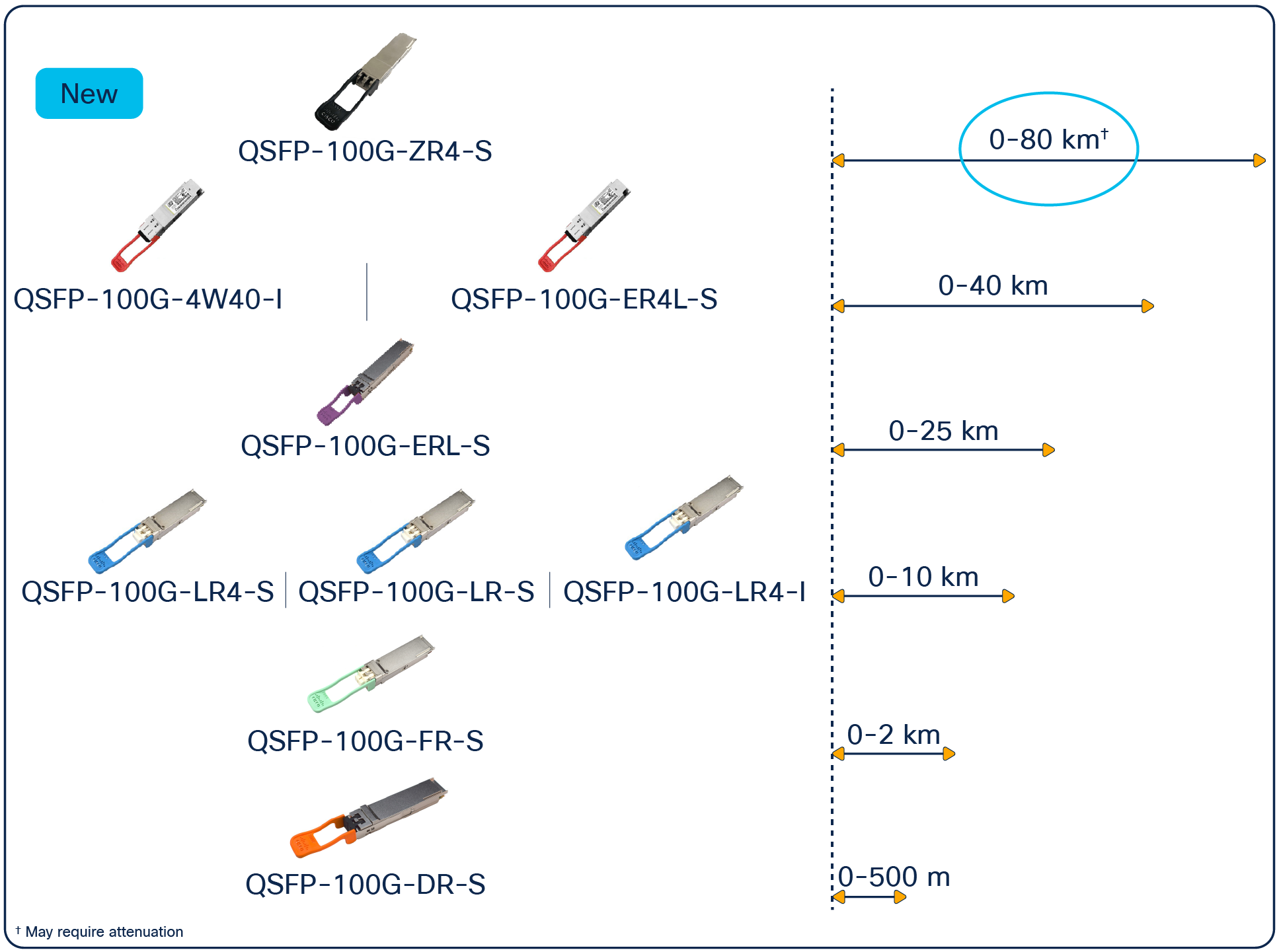
With the addition of the QSFP-100G-ZR4-S, network operators and integrators now have a comprehensive suite of 100G modules from 0 to 80 km
The QSFP-100G-ZR4-S is particularly effective in extended-reach applications, such as across a large metropolitan area or rural county. Particularly for networks that are power, space, or cost constrained, it can be a true game changer.
● Enterprise: The QSFP-100G-ZR4-S is an effective solution for connecting enterprises to other metro or remote locations such as offices to retail locations, factories, warehouses, or medical facilities (see Figure 5). It also supports private clouds and privately managed failover/disaster recovery operations. In each case, the need is the same-to provide a high-speed, reliable connection from one edge router to another at reaches of up to 80 km.

Enterprise application of the QSFP-100G-ZR4-S
● Connecting to a regional data center: As businesses offload their applications to regional data centers, high-bandwidth connectivity becomes very important. The QSFP-100G-ZR4-S delivers the speed, reliability, and ease of use necessary to build out this critical infrastructure at distances as long as 80 km (see Figure 6)
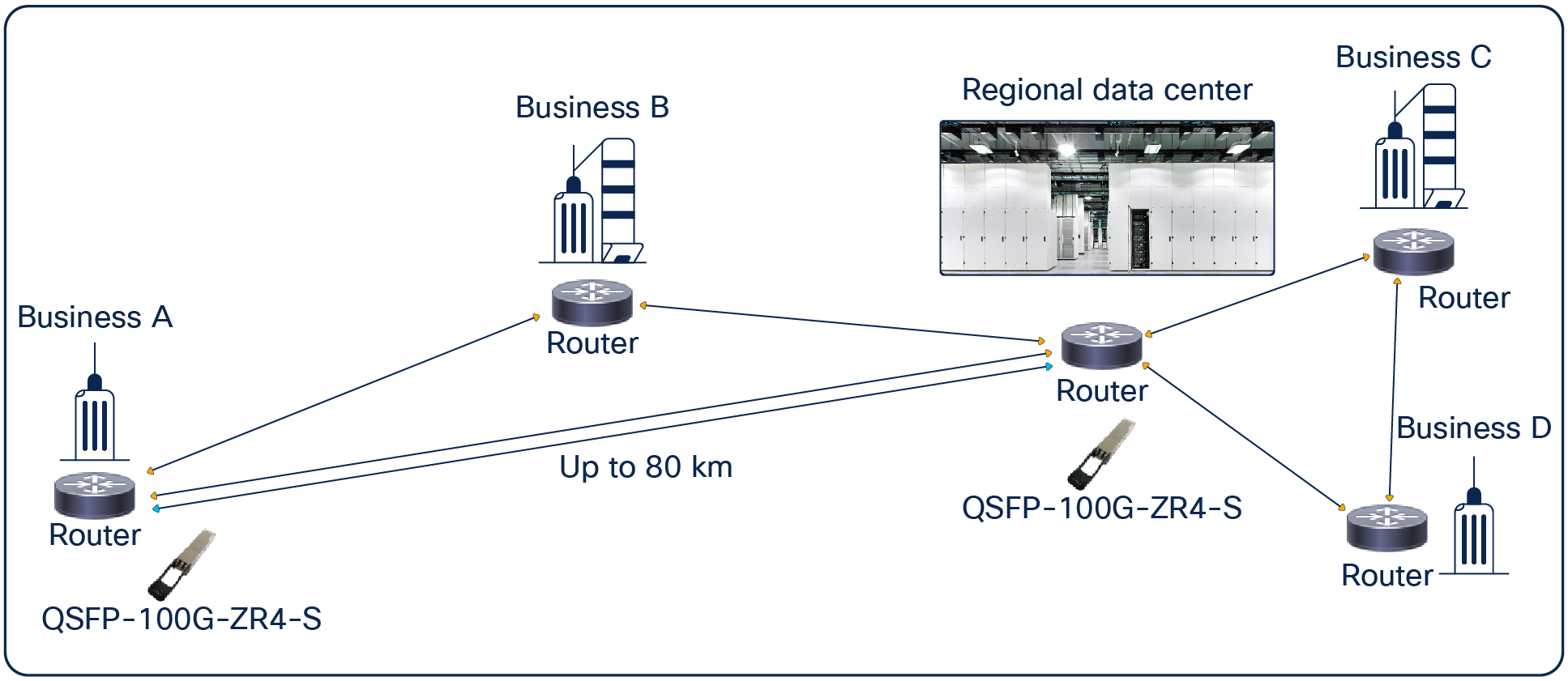
Connecting to regional data center application using the QSFP-100G-ZR4-S
● Service providers: Service providers such as telcos, cable companies, and utilities can use the extended reach of QSFP-100G-ZR4-S modules to link central offices or provide customers 100G services (see Figure 7). The solution provides high bandwidth and avoids expensive intermediate repeater locations for links up to 80 km.
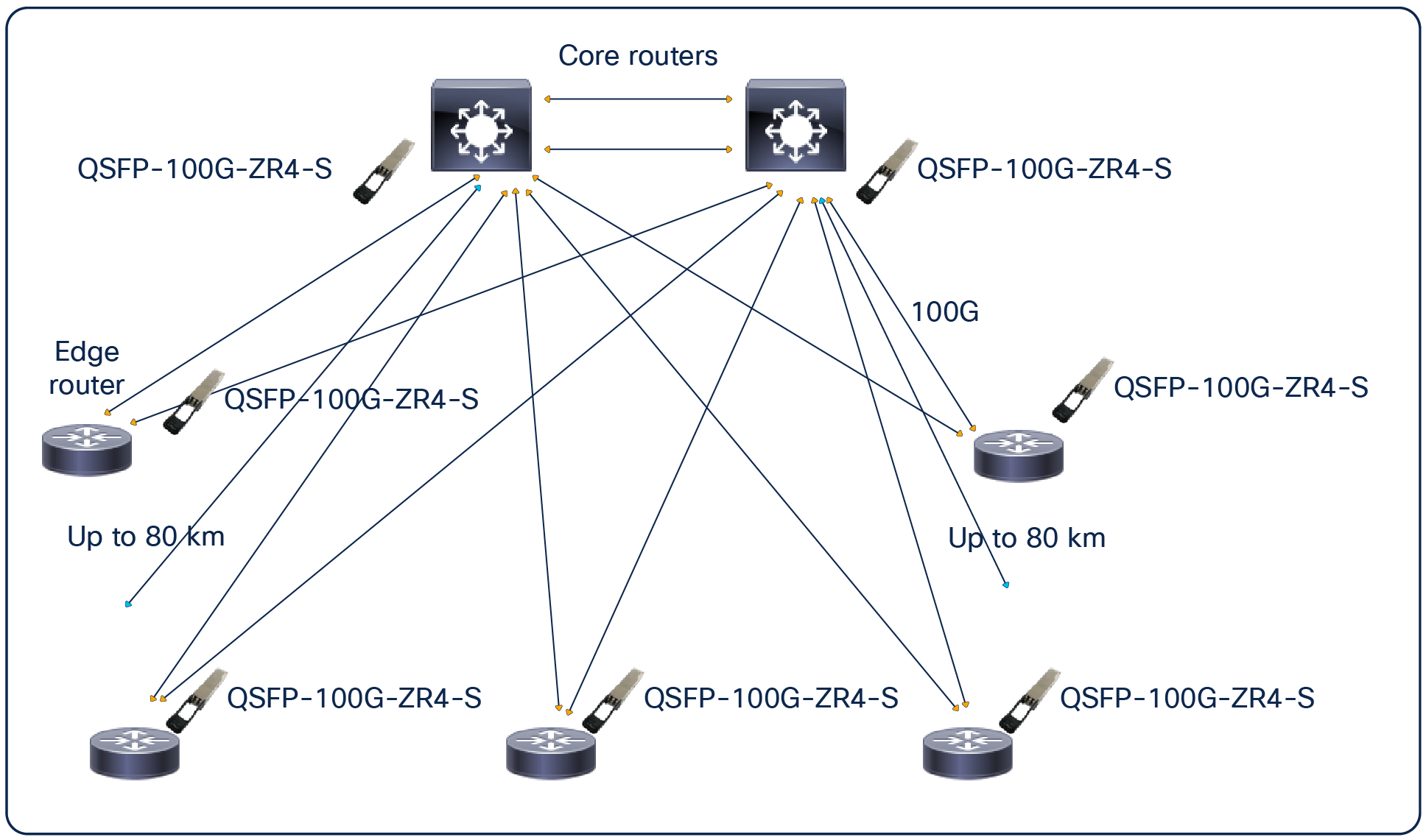
Service provider application of the QSFP-100G-ZR4-S
● Rural broadband: There are many government sponsored initiatives around the globe designed to support the construction and operation of high-speed rural networks. With its 80 km reach, the QSFP-100G-ZR4-S module provides the missing piece to help telcos upgrade their rural networks to 100G as they seek to bridge the digital divide (see Figure 8).
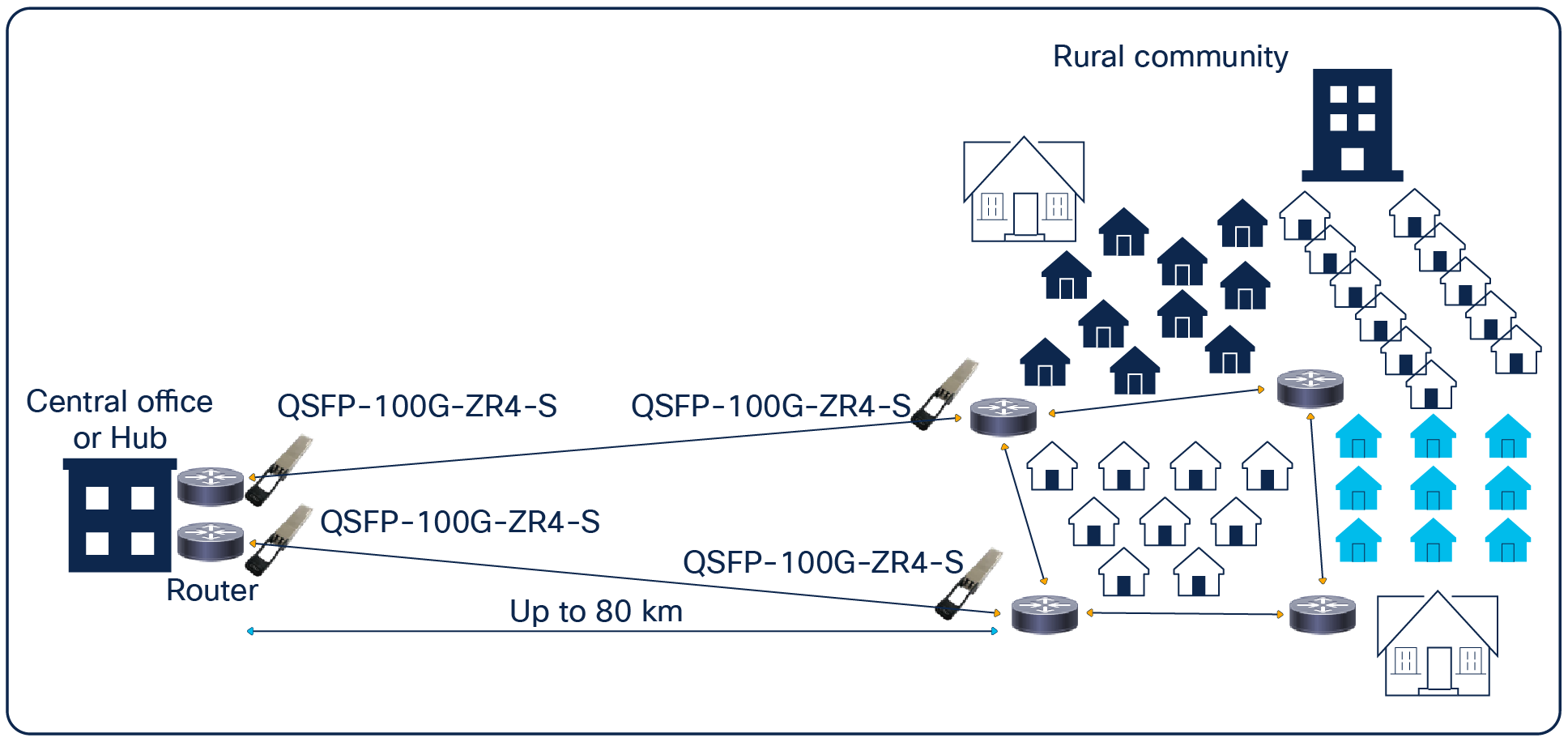
Rural broadband application of the QSFP-100G-ZR4-S
● Mobile: Particularly as 5G ramps up, wireless providers need 100G links to aggregate 4G and 5G traffic. QSFP-100G-ZR4-S modules can be used to connect aggregation routers with core routers, offering long enough reach to serve distant decentralized locations at reaches up to 80 km (see Figure 9).
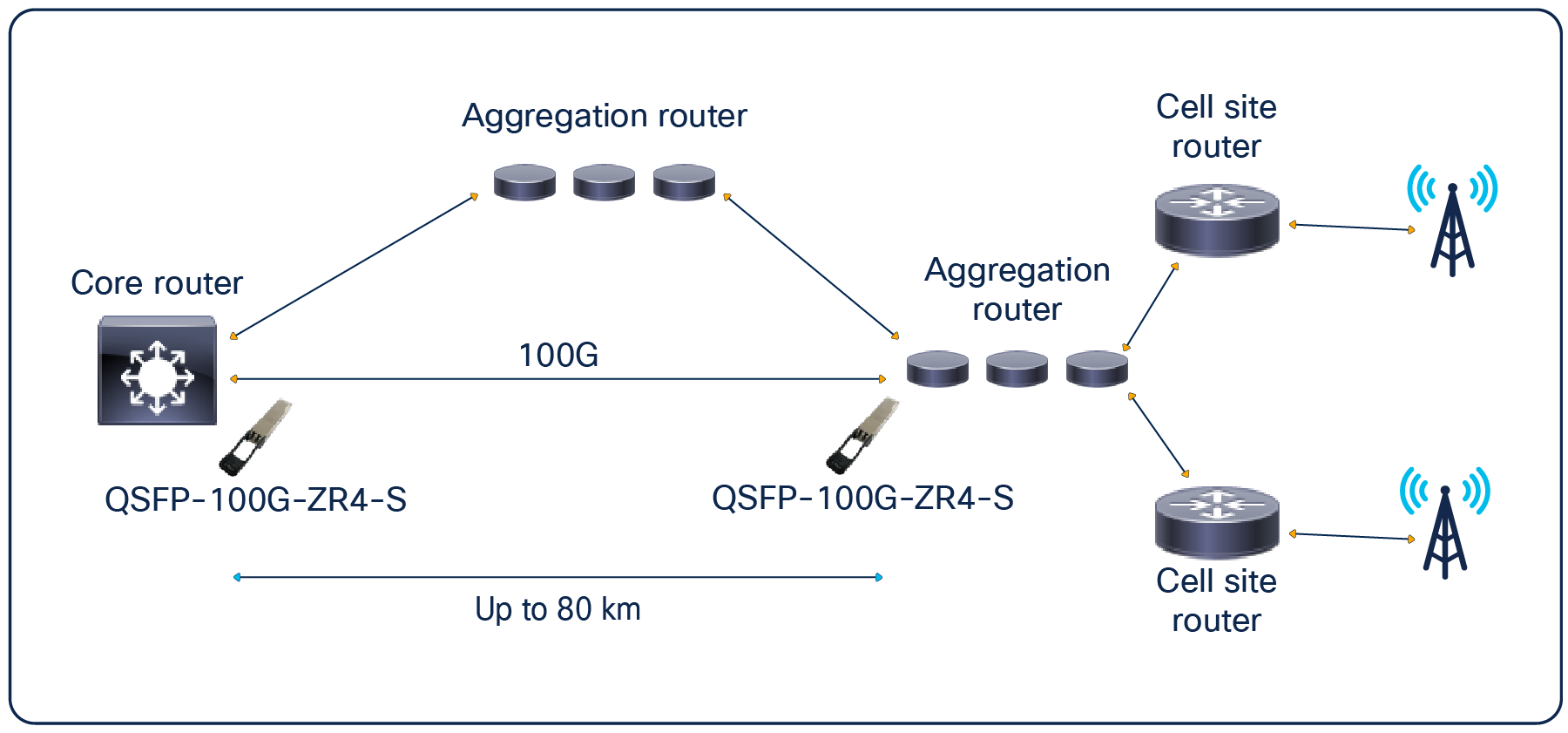
Mobile application of the QSFP-100G-ZR4-S
Breaking the 80 km Bandwidth Bottleneck
The QSFP-100G-ZR4-S pluggable module represents more than just a capacity upgrade. It extends 100G in the familiar QSFP28 footprint to reaches as long as 80 km. Using the QSFP-100G-ZR4-S, operators of wide-range networks can transform their capacity and customer offerings. Enterprises, service providers, and wireless operators, as well as telcos serving rural networks, can use these modules to bring 100G speeds over greater distances. They can maximize network efficiency, freeing up fibers for other applications or releasing them entirely.
Featuring an integrated SOA, QSFP-100G-ZR4-S modules are smaller, simpler, and less expensive and consume less power than the combination of standard module and external amplifier. To that, add ease of use and speed of installation and maintenance. The modules round out the Cisco 100G QSFP28 product portfolio100 m, 500 m, 2 km, 10 km, 25 km, 40 km, and, now, 80 km-giving network operators the flexibility to offer services at multiple reaches depending on the customer use case.
Find out how the QSFP-100G-ZR4-S can help you transform your network offerings. Contact your local Cisco representative at cs.co/askoptics
Further reading
● Cisco Optics-to-Device Compatibility Matrix (platforms to be added as software becomes available)
● Cisco Optics-to-Optics Interoperability Matrix
● Cisco Optics Product Information
● Cisco QSFP-100G-ZR4-S Pluggable Transceiver At-a-Glance
● Cisco 100GBASE QSFP-100G Modules Data Sheet